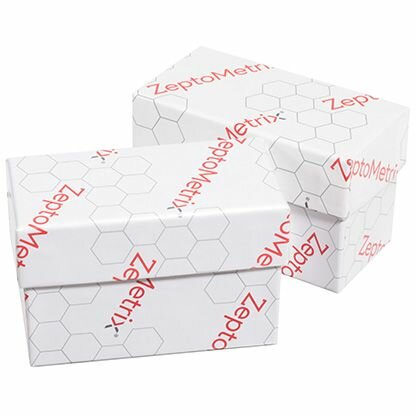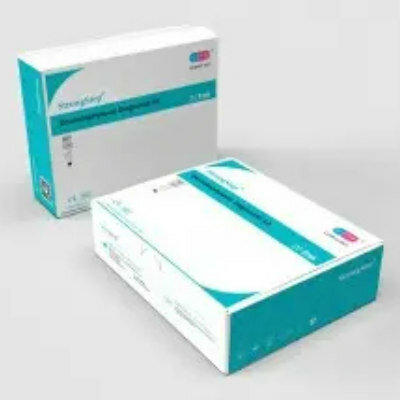Increasingly Efficient Serological Tests Developed with Electrochemiluminescence
|
By LabMedica International staff writers Posted on 17 Jun 2020 |
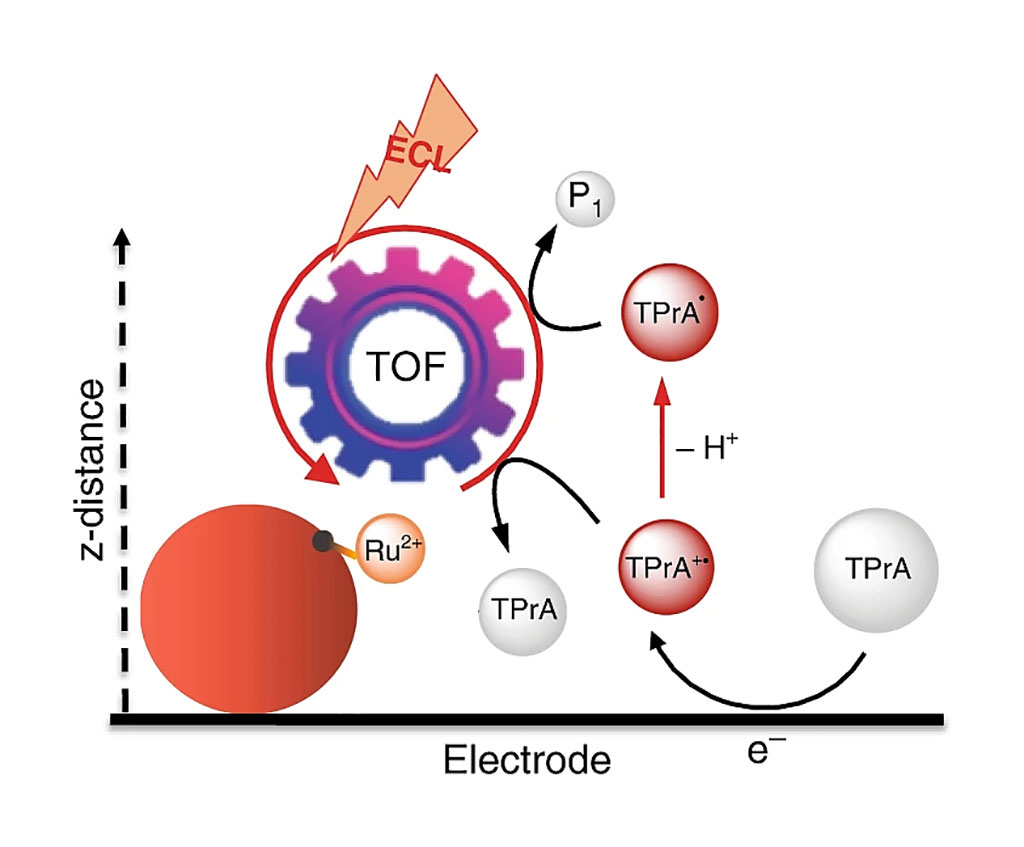
Image: Schematic representation of the remote electrochemiluminescence (ECL) mechanism (Photo courtesy of University of Bologna).
Diagnostic markers, or biomarkers, are biomolecules (e.g., enzymes, proteins, peptides, and hormones) that can be measured accurately and reproducibly and can precisely predict relevant clinical outcomes or diseases in various populations.
In fact, biomarkers represent a powerful aid in clinical diagnostic and therapeutic monitoring. Therefore, detection, identification, and quantification of such molecules can translate into the development of sophisticated methods and instrumentations for analyzing clinically useful biomarkers.
Medical Chemists at the University of Bologna (Bologna, Italy) and their colleagues discovered an unexpected but highly efficient mechanistic path for electrochemiluminescence (ECL) generation close to the electrode surface (signal enhancement, 128%) using an innovative combination of ECL imaging techniques and electrochemical mapping of radical generation.
The team used through the combination of ECL and microscopy and the use of labeled microbeads, they mapped ECL generation close to the electrode surface (≤1 µm), thus revealing the contribution of an additional pathway to ECL generation, which was unobserved to date. This additional mechanism exhibits a very high efficiency, i.e., 10 times more intense than the signals measured at larger distances (>1 µm).
The scientists identified a family of alternative coreactants/additives, namely branched amines, which may lead to an advantageous overall signal enhancement. In particular, the use of N-dipropyl isobutyl amine (DPIBA) enhances the ECL signal by a maximum of 47% in a commercial immunoassay system for the quantification of several biomarkers, such as thyroid stimulating hormone (TSH), cardiac troponin T, ferritin, and immunoglobulin (Ig)M antibodies against Toxoplasma gondii (Toxo IgM) and hepatitis A (A‐HAV IgM). A series of commercially available Elecsys assays (Roche Diagnostics, Indianapolis, IN) for the detection of those specific biomarkers was used on a Roche cobas e 801 immunoassay analyzer to evaluate the effect of DPIBA on the assay performance.
Alessandra Zanut, PhD, a Physical Chemist and first author of the study, said, “From these results, we managed to identify highly efficient reactants that are able to enhance the sensitivity of this technique way beyond that currently employed for serological tests. With this technique, we obtained an ECL signal enhancement up to 128% compared to current techniques.” The study was published on May 29, 2020 in the journal Nature Communications.
In fact, biomarkers represent a powerful aid in clinical diagnostic and therapeutic monitoring. Therefore, detection, identification, and quantification of such molecules can translate into the development of sophisticated methods and instrumentations for analyzing clinically useful biomarkers.
Medical Chemists at the University of Bologna (Bologna, Italy) and their colleagues discovered an unexpected but highly efficient mechanistic path for electrochemiluminescence (ECL) generation close to the electrode surface (signal enhancement, 128%) using an innovative combination of ECL imaging techniques and electrochemical mapping of radical generation.
The team used through the combination of ECL and microscopy and the use of labeled microbeads, they mapped ECL generation close to the electrode surface (≤1 µm), thus revealing the contribution of an additional pathway to ECL generation, which was unobserved to date. This additional mechanism exhibits a very high efficiency, i.e., 10 times more intense than the signals measured at larger distances (>1 µm).
The scientists identified a family of alternative coreactants/additives, namely branched amines, which may lead to an advantageous overall signal enhancement. In particular, the use of N-dipropyl isobutyl amine (DPIBA) enhances the ECL signal by a maximum of 47% in a commercial immunoassay system for the quantification of several biomarkers, such as thyroid stimulating hormone (TSH), cardiac troponin T, ferritin, and immunoglobulin (Ig)M antibodies against Toxoplasma gondii (Toxo IgM) and hepatitis A (A‐HAV IgM). A series of commercially available Elecsys assays (Roche Diagnostics, Indianapolis, IN) for the detection of those specific biomarkers was used on a Roche cobas e 801 immunoassay analyzer to evaluate the effect of DPIBA on the assay performance.
Alessandra Zanut, PhD, a Physical Chemist and first author of the study, said, “From these results, we managed to identify highly efficient reactants that are able to enhance the sensitivity of this technique way beyond that currently employed for serological tests. With this technique, we obtained an ECL signal enhancement up to 128% compared to current techniques.” The study was published on May 29, 2020 in the journal Nature Communications.
Latest Immunology News
- Stem Cell Test Predicts Treatment Outcome for Patients with Platinum-Resistant Ovarian Cancer
- Machine Learning-Enabled Blood Test Predicts Immunotherapy Response in Lymphoma Patients
- Post-Treatment Blood Test Could Inform Future Cancer Therapy Decisions
- Cerebrospinal Fluid Test Predicts Dangerous Side Effect of Cancer Treatment
- New Test Measures Preterm Infant Immunity Using Only Two Drops of Blood
- Simple Blood Test Could Help Choose Better Treatments for Patients with Recurrent Endometrial Cancer
- Novel Analytical Method Tracks Progression of Autoimmune Diseases
- 3D Bioprinted Gastric Cancer Model Uses Patient-Derived Tissue Fragments to Predict Drug Response
- Blood Test for Fungal Infections Could End Invasive Tissue Biopsies
- Cutting-Edge Microscopy Technology Enables Tailored Rheumatology Therapies
- New Discovery in Blood Immune Cells Paves Way for Parkinson's Disease Diagnostic Test
- AI Tool Uses Routine Blood Tests to Predict Immunotherapy Response for Various Cancers
- Blood Test Can Predict How Long Vaccine Immunity Will Last
- Microfluidic Chip-Based Device to Measure Viral Immunity
Channels
Clinical Chemistry
view channel
‘Brilliantly Luminous’ Nanoscale Chemical Tool to Improve Disease Detection
Thousands of commercially available glowing molecules known as fluorophores are commonly used in medical imaging, disease detection, biomarker tagging, and chemical analysis. They are also integral in... Read more
Low-Cost Portable Screening Test to Transform Kidney Disease Detection
Millions of individuals suffer from kidney disease, which often remains undiagnosed until it has reached a critical stage. This silent epidemic not only diminishes the quality of life for those affected... Read more
New Method Uses Pulsed Infrared Light to Find Cancer's 'Fingerprints' In Blood Plasma
Cancer diagnoses have traditionally relied on invasive or time-consuming procedures like tissue biopsies. Now, new research published in ACS Central Science introduces a method that utilizes pulsed infrared... Read moreMolecular Diagnostics
view channel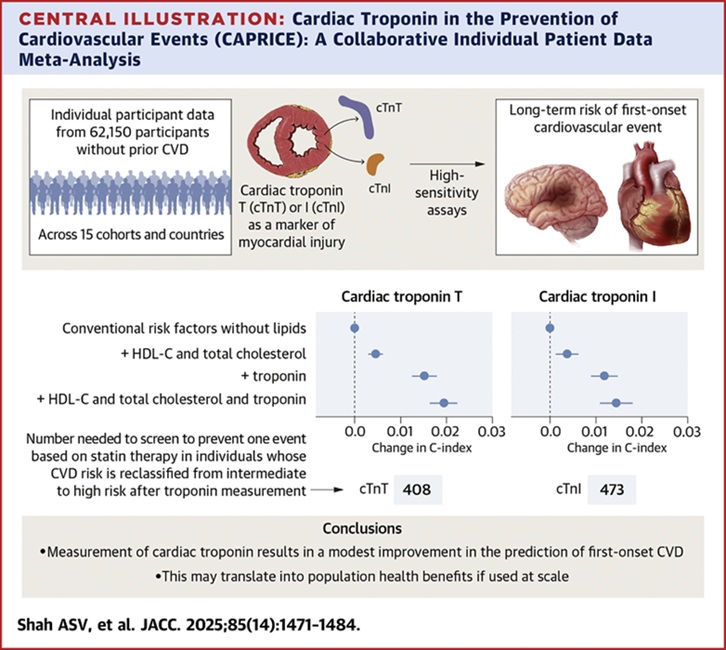
Simple Blood Test Improves Heart Attack and Stroke Risk Prediction
Troponin is a protein found in heart muscle cells that is released into the bloodstream when the heart is damaged. High-sensitivity troponin blood tests are commonly used in hospitals to diagnose heart... Read more
Blood Biomarker Test Could Detect Genetic Predisposition to Alzheimer’s
New medications for Alzheimer’s disease, the most common form of dementia, are now becoming available. These treatments, known as “amyloid antibodies,” work by promoting the removal of small deposits from... Read more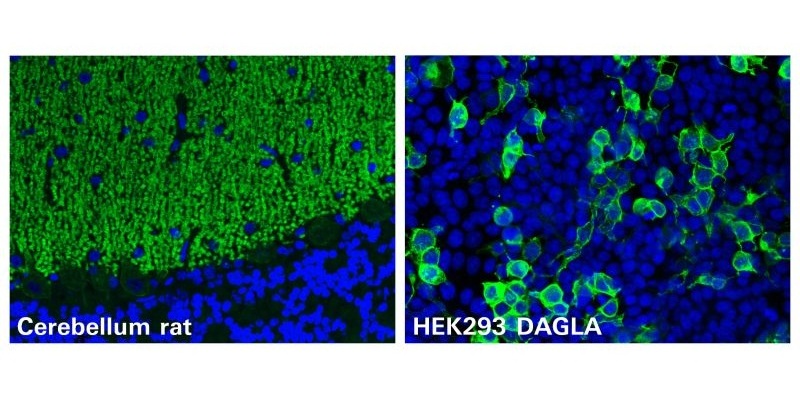
Novel Autoantibody Against DAGLA Discovered in Cerebellitis
Autoimmune cerebellar ataxias are strongly disabling disorders characterized by an impaired ability to coordinate muscle movement. Cerebellar autoantibodies serve as useful biomarkers to support rapid... Read more
Gene-Based Blood Test Accurately Predicts Tumor Recurrence of Advanced Skin Cancer
Melanoma, an aggressive form of skin cancer, becomes extremely difficult to treat once it spreads to other parts of the body. For patients with metastatic melanoma tumors that cannot be surgically removed... Read moreHematology
view channel
New Scoring System Predicts Risk of Developing Cancer from Common Blood Disorder
Clonal cytopenia of undetermined significance (CCUS) is a blood disorder commonly found in older adults, characterized by mutations in blood cells and a low blood count, but without any obvious cause or... Read more
Non-Invasive Prenatal Test for Fetal RhD Status Demonstrates 100% Accuracy
In the United States, approximately 15% of pregnant individuals are RhD-negative. However, in about 40% of these cases, the fetus is also RhD-negative, making the administration of RhoGAM unnecessary.... Read moreMicrobiology
view channel
Handheld Device Delivers Low-Cost TB Results in Less Than One Hour
Tuberculosis (TB) remains the deadliest infectious disease globally, affecting an estimated 10 million people annually. In 2021, about 4.2 million TB cases went undiagnosed or unreported, mainly due to... Read more
New AI-Based Method Improves Diagnosis of Drug-Resistant Infections
Drug-resistant infections, particularly those caused by deadly bacteria like tuberculosis and staphylococcus, are rapidly emerging as a global health emergency. These infections are more difficult to treat,... Read more
Breakthrough Diagnostic Technology Identifies Bacterial Infections with Almost 100% Accuracy within Three Hours
Rapid and precise identification of pathogenic microbes in patient samples is essential for the effective treatment of acute infectious diseases, such as sepsis. The fluorescence in situ hybridization... Read morePathology
view channel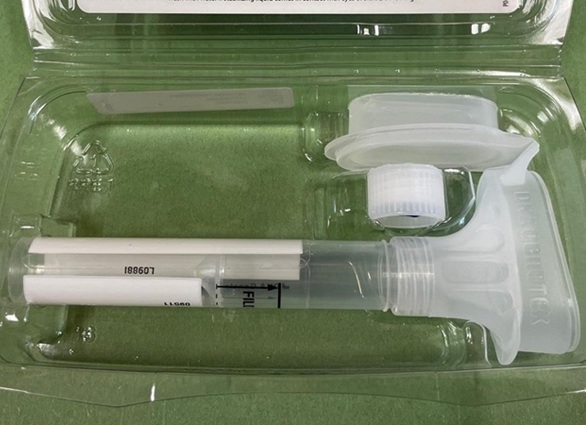
Spit Test More Accurate at Identifying Future Prostate Cancer Risk
Currently, blood tests that measure the level of a protein called prostate-specific antigen (PSA) are commonly used to identify men at higher risk for prostate cancer. This test is typically used based... Read moreDNA Nanotechnology Boosts Sensitivity of Test Strips
Since the Covid-19 pandemic, most people have become familiar with paper-based rapid test strips, also known as lateral flow immunoassays (LFIAs). These tests are used to quickly detect biomarkers that... Read more
Novel UV and Machine Learning-Aided Method Detects Microbial Contamination in Cell Cultures
Cell therapy holds great potential in treating diseases such as cancers, inflammatory conditions, and chronic degenerative disorders by manipulating or replacing cells to restore function or combat disease.... Read moreTechnology
view channel
Disposable Microchip Technology Could Selectively Detect HIV in Whole Blood Samples
As of the end of 2023, approximately 40 million people globally were living with HIV, and around 630,000 individuals died from AIDS-related illnesses that same year. Despite a substantial decline in deaths... Read more
Pain-On-A-Chip Microfluidic Device Determines Types of Chronic Pain from Blood Samples
Chronic pain is a widespread condition that remains difficult to manage, and existing clinical methods for its treatment rely largely on self-reporting, which can be subjective and especially problematic... Read more
Innovative, Label-Free Ratiometric Fluorosensor Enables More Sensitive Viral RNA Detection
Viruses present a major global health risk, as demonstrated by recent pandemics, making early detection and identification essential for preventing new outbreaks. While traditional detection methods are... Read moreIndustry
view channel
Cepheid and Oxford Nanopore Technologies Partner on Advancing Automated Sequencing-Based Solutions
Cepheid (Sunnyvale, CA, USA), a leading molecular diagnostics company, and Oxford Nanopore Technologies (Oxford, UK), the company behind a new generation of sequencing-based molecular analysis technologies,... Read more
Grifols and Tecan’s IBL Collaborate on Advanced Biomarker Panels
Grifols (Barcelona, Spain), one of the world’s leading producers of plasma-derived medicines and innovative diagnostic solutions, is expanding its offer in clinical diagnostics through a strategic partnership... Read more







